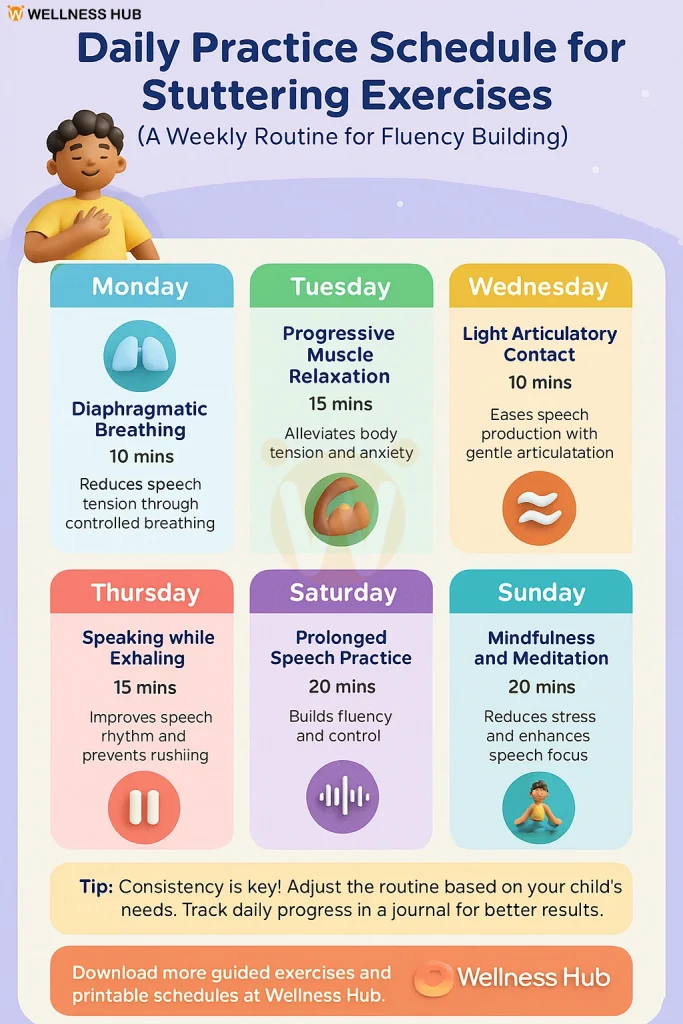12 Effective Stuttering Exercises for Adults at Home
By Rajini D
Last Updated: February 24, 2024
Stuttering, a speech disorder that affects many adults worldwide, is more than just an occasional stumble over words. It can significantly impact one’s confidence and daily communication. Despite its prevalence, stuttering remains a challenge that many adults face silently, often due to limited access to professional help or the stigma surrounding speech therapy.
These exercises are more than just techniques; they are steps toward regaining your confidence in speech and expression. Rest assured, the exercises we’re about to explore are both practical and beneficial. They have been carefully chosen to suit adults looking to improve their speech fluency right at home. Whether you’re someone who has struggled with stuttering for years or are only beginning to notice speech difficulties, these strategies are crafted to provide you with the tools you need for better speech management.
Understanding Stuttering in Adults
What is Stuttering?
Stuttering, often perceived as a mere repetition or prolongation of sounds, is actually a complex communication disorder. It affects the fluency of speech, where the flow of words is interrupted by involuntary repetitions and prolongations of sounds, syllables, or even words. Stuttering can also involve involuntary silent pauses or blocks in which the person is unable to produce sounds.
The Causes of Stuttering
The exact causes of stuttering are not fully understood, but research suggests a combination of factors. These include genetic predisposition, neurological factors, and environmental influences. Some people might stutter due to an inherited tendency that affects the way the brain processes language. Others might experience stuttering as a result of developmental delays during childhood or neurological events such as a stroke or brain injury.
Learn more about History of Autism: Unraveling Autism’s History
Types of Stuttering
- Neurogenic Stuttering: This form of stuttering occurs after a person suffers from a brain injury, like a stroke or traumatic brain injury (TBI). It happens because the brain’s language and speech production areas are affected, disrupting the coordination required for smooth speech.
- Developmental Stuttering: Most common in children during their speech and language development stages, this type of stuttering can persist into adulthood. It’s typically associated with the developmental process of learning to speak.
- Adult-Onset Stuttering: Sometimes, adults develop stuttering even without a history of the disorder in childhood. This can be due to psychological stress, emotional trauma, or other neurological reasons.
For more insights on Early Identification/ Warning Signs in child development
Comparison of Stuttering Types
| Type of Stuttering | Causes | Characteristics |
|---|---|---|
| Neurogenic Stuttering | Brain injury (such as stroke or TBI), neurological disorders | Sudden onset, difficulty with word initiation, less anxiety-driven |
| Developmental Stuttering | Genetic predisposition, developmental delays in speech and language | Common in childhood, repetition of sounds or words, speech interruptions |
| Adult-Onset Stuttering | Psychological stress, emotional trauma, or other neurological reasons | Starts in adulthood, is often linked to specific events or stressors, and varies in severity |
The Importance of Personalized Approaches
Each individual’s experience with stuttering is unique. That’s why personalized approaches to managing stuttering are crucial. The strategies that work well for one person might not be as effective for another. It’s important to understand one’s specific challenges with stuttering to develop an effective management plan. This individualized approach not only addresses the specific needs of the stutterer but also helps in building strategies that are more sustainable and effective in the long run.
Also Read: Understanding the Role of Speech Therapists in Online Settings
The Role of Speech Therapy in Stuttering Management
The Benefits of Professional Speech Therapy
Speech therapy plays a pivotal role in managing stuttering, especially for adults. It’s not just about teaching techniques to control stuttering; it’s a comprehensive approach that addresses the emotional, psychological, and practical aspects of this speech disorder. Professional speech therapists work to develop personalized strategies that help individuals understand their speech patterns, identify triggers, and implement techniques to improve fluency. These strategies often include exercises in breath control, articulation, and even cognitive restructuring to help manage the anxieties associated with stuttering.
Moreover, speech therapy isn’t just about managing stuttering in the short term. It equips individuals with lifelong skills and techniques to handle various speaking situations confidently, from casual conversations to professional presentations. This holistic approach ensures that the improvements in speech are not just temporary fixes but lasting changes that enhance overall communication skills.
Continue Reading on Improve Speech Fluency with Yoga for Stuttering
The Value of At-Home Exercises
We acknowledge that not everyone has the privilege of easy access to professional speech therapy. Various factors, including geographical, financial, or even personal reasons, can limit this access. However, this should not be a barrier to improving one’s speech fluency. This is where at-home exercises for stuttering management become invaluable. These exercises are designed to be practical, easy to integrate into daily routines, and, most importantly, effective.
At-home exercises for stuttering management are not just about speech techniques. They also include activities to reduce stress, improve breathing and relaxation, and build overall confidence in communication. They are a testament to the fact that improvement in stuttering management is possible, even outside the conventional settings of a therapist’s office.
12 Effective Exercises to Do at Home
1. Diaphragmatic Breathing:
- Description: Diaphragmatic breathing involves deep breathing using the diaphragm rather than shallow breaths from the chest. It’s essential for controlling the breath during speech.
- Step-by-Step Guide: Lie down or sit comfortably. Place one hand on your chest and the other on your belly. Breathe in slowly through your nose, ensuring your belly rises more than your chest. Exhale slowly through the mouth. Practice this for 5-10 minutes daily.
Learn more about how oral motor exercises can complement breathing techniques.
2. Progressive Muscle Relaxation:
- Techniques: Focus on gradually tensing and then relaxing each muscle group. Start from your toes, moving upwards to your legs, abdomen, arms, and face.
- Benefits: Reduces overall muscle tension and can help alleviate the physical manifestations of stuttering, like facial tics.
Also Read: Overall Wellness Starts When the Inner Trauma is Healed
3. Light Articulatory Contact:
- Explanation: This technique involves using a lighter touch of the tongue, lips, and teeth during speech to reduce tension.
- Application: Practice saying words with light contacts, focusing on the sensation of reduced pressure. Start with words like “butter,” where the lips come together lightly.
4. Speaking While Exhaling:
- How it Helps: Speaking while you exhale relaxes your vocal cords and reduces stuttering.
- Practice Tips: Start by taking a deep breath. Begin speaking as you exhale, focusing on maintaining a steady, relaxed breath.
5. Pausing and Phrasing:
- Techniques: Intentionally insert pauses in your sentences and break longer sentences into shorter phrases.
- Benefits: Helps in managing the rhythm of speech and reduces the rush of words, which can trigger stuttering.
6. Prolonged Speech:
- Description: This involves elongating syllables and stretching out words to slow down speech.
- Application: Combine light articulation with pausing. Start by exaggerating the elongation and gradually reducing it to a natural level.
7. Pull Outs:
- Strategies: When you feel a stutter coming, consciously stretch out the word. Then, slowly and smoothly transition into the rest of your sentence.
Also Read: The Speech Chain: Understanding How We Communicate
8. Mindfulness and Meditation:
- Benefits: Reduces stress and improves focus, which can positively impact speech fluency.
- Practice: Spend a few minutes each day in quiet reflection or guided meditation, focusing on your breath and present sensations.
9. Yoga for Speech Fluidity:
- Recommended Poses: Simple yoga poses like the warrior, tree, and mountain pose can help.
- Benefits: Improves breath control and posture and reduces stress, all of which are beneficial for smooth speech.
Also Read: What are the therapies offered to Autistic patients? | Therapies of Autism
10. Journaling Progress:
Importance: Keeping a journal of your daily speech exercises and any improvements in your fluency can be incredibly motivating and insightful.
Learn more about on How is Psychological Counseling Beneficial? | Is Online Counseling Advantageous?
11. Challenging Personal Boundaries:
- Setting Goals: Set small, achievable speech goals each week.
- Overcoming Fears: Gradually expose yourself to more challenging speaking situations.
12. Aerobic Exercises:
- Impact: Physical exercises like walking, jogging, or cycling improve overall cardiovascular health, which enhances breath control and speech fluency.
Integrating Exercises into Daily Life

Tips for Making These Exercises a Part of Your Daily Routine:
- Schedule a Specific Time: Consistency is key. Set aside a specific time each day for these exercises. Whether it’s first thing in the morning, during a lunch break, or in the evening, having a dedicated time helps establish a routine.
- Create a Comfortable Space: Find a quiet, comfortable spot in your home where you can practice without interruptions. This could be a small corner in your bedroom or a peaceful spot in your living room.
- Start Small: Begin with short sessions. Even 5-10 minutes a day can make a significant difference. Gradually increase the duration as you become more comfortable with the exercises.
- Integrate Exercises into Daily Activities: Try to incorporate some of the exercises, like diaphragmatic breathing or light articulatory contact, into your regular conversations. This practice can make these techniques more natural and effective.
- Track Your Progress: Keep a journal or use a digital app to note down your daily practice and any improvements you observe. This can be highly motivating and provide valuable insights into what works best for you.
- Be Patient and Kind to Yourself: Remember that progress in managing stuttering takes time. Be patient and acknowledge every small victory along the way.
Exercise Schedule for Stuttering Management
| Day of the Week | Exercise | Duration |
|---|---|---|
| Monday | Diaphragmatic Breathing | 10 minutes |
| Tuesday | Progressive Muscle Relaxation | 15 minutes |
| Wednesday | Light Articulatory Contact | 10 minutes |
| Thursday | Speaking While Exhaling | 10 minutes |
| Friday | Pausing and Phrasing | 15 minutes |
| Saturday | Prolonged Speech Practice | 20 minutes |
| Sunday | Mindfulness and Meditation | 20 minutes |
Leveraging Technology and Community Support
Utilizing Technology for Additional Support:
- Speech Therapy Apps: There are several apps available that are designed to assist with stuttering management. These apps offer exercises, tips, and even personal tracking features to monitor your progress.
- Online Resources: Websites like Wellness Hub offer a wealth of information, from detailed articles to expert advice on stuttering management. These resources can be an excellent supplement to your daily practice.
- Video Tutorials: Platforms like YouTube have numerous tutorials on speech exercises. Watching and following these can be a helpful visual guide.
Conclusion
Discover the power of simple exercises to manage stuttering and boost your confidence from home! Dive into techniques like diaphragmatic breathing, muscle relaxation, and mindfulness. Regularly practicing these steps can truly enhance your speech fluency. Remember, improvement takes time and patience, so celebrate every small win along the way. Need extra support? Visit Wellness Hub for expert advice and more resources to help you speak smoothly. Start your journey to confident communication today—every word counts!
Frequently Asked Questions:
1. What are effective home exercises for adult stuttering management?
Effective home exercises include diaphragmatic breathing, progressive muscle relaxation, light articulatory contact, speaking while exhaling, pausing and phrasing, prolonged speech, pullouts, mindfulness and meditation, yoga, journaling progress, challenging personal boundaries, and aerobic exercises.
2. How does diaphragmatic breathing help in stuttering management?
Diaphragmatic breathing aids in controlling the breath during speech, promoting relaxation, and reducing the frequency and severity of stuttering episodes. It involves deep breathing using the diaphragm rather than shallow chest breaths.
3. Can yoga and meditation improve speech fluency in stuttering adults?
Yes, yoga and meditation can significantly improve speech fluency. These practices reduce stress and anxiety, enhance breath control, and improve overall relaxation, contributing to smoother speech.
4. Are there any online resources for stuttering management exercises?
Online resources like Wellness Hub offer various exercises, tips, and guidance for stuttering management. Additionally, speech therapy apps and video tutorials on platforms like YouTube can be beneficial.
5. Is it possible to manage stuttering without professional therapy?
While professional therapy is highly recommended, many individuals manage stuttering effectively with at-home exercises. Consistency, patience, and the right techniques can lead to significant improvements.
6. How long does it take to see improvement in stuttering with home exercises?
The time to see improvement varies for each individual. Consistent daily practice of exercises can lead to gradual improvements over weeks or months. Patience and persistence are key.
7. What role does journaling play in managing adult stuttering?
Journaling helps track progress, set goals, and reflect on daily speech patterns. It’s a motivational tool that allows individuals to notice and celebrate small improvements in their stuttering management journey.
8. Can group therapy or support groups help in stuttering management?
Yes, group therapy and support groups offer a platform to practice speaking skills in a supportive environment, share experiences, and learn from others who are also managing stuttering.
About the Author:
Rajini Darugupally
M.Sc., Speech-Language Pathologist (9+ years of experience)
Rajini is a passionate and dedicated Speech-Language Pathologist with over 9+ years of experience, specializing in both developmental speech and language disorders in children and rehabilitation in adults. Driven by a desire to empower each individual to find their voice, Rajini brings a wealth of experience and a warm, genuine approach to therapy.
Currently, at Wellness Hub, she thrives in a team environment that values innovation, compassion, and achieving results for their clients.
Connect with Rajini to learn more about how she can help you or your loved one find their voice.
Book your Free Consultation Today
Parent/Caregiver Info:
Client’s Details:
* Error Message









